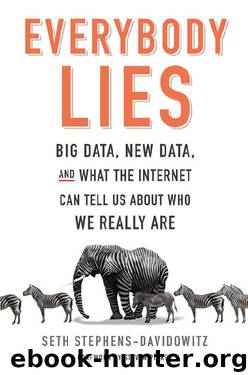Everybody Lies: Big Data, New Data, and What the Internet Can Tell Us About Who We Really Are by Seth Stephens-Davidowitz

Author:Seth Stephens-Davidowitz [Stephens-Davidowitz, Seth]
Language: eng
Format: epub, azw3
ISBN: 9780062390875
Publisher: HarperCollins
Published: 2017-05-09T07:00:00+00:00
My personal favorite study by Raj Chetty’s team, which had access to that massive collection of IRS data, was their inquiry into why some people cheat on their taxes while others do not. Explaining this study is a bit more complicated.
The key is knowing that there is an easy way for self-employed people with one child to maximize the money they receive from the government. If you report that you had taxable income of exactly $9,000 in a given year, the government will write you a check for $1,377—that amount represents the Earned Income Tax Credit, a grant to supplement the earnings of the working poor, minus your payroll taxes. Report any more than that, and your payroll taxes will go up. Report any less than that, and the Earned Income Tax Credit drops. A taxable income of $9,000 is the sweet spot.
And, wouldn’t you know it, $9,000 is the most common taxable income reported by self-employed people with one child.
Did these Americans adjust their work schedules to make sure they earned the perfect income? Nope. When these workers were randomly audited—a very rare occurrence—it was almost always found that they made nowhere near $9,000—they earned either substantially less or substantially more.
In other words, they cheated on their taxes by pretending they made the amount that would give them the fattest check from the government.
So how typical was this type of tax fraud and who among the self-employed with one child was most likely to commit it? It turns out, Chetty and colleagues reported, that there were huge differences across the United States in how common this type of cheating was. In Miami, among people in this category, an astonishing 30 percent reported they made $9,000. In Philadelphia, just 2 percent did.
What predicts who is going to cheat? What is it about places that have the greater number of cheaters and those that have lower numbers? We can correlate rates of cheating with other city-level demographics and it turns out that there are two strong predictors: a high concentration of people in the area qualifying for the Earned Income Tax Credit and a high concentration of tax professionals in the neighborhood.
What do these factors indicate? Chetty and the authors had an explanation. The key motivator for cheating on your taxes in this manner was information.
Most self-employed one-kid taxpayers simply did not know that the magic number for getting a big fat check from the government was $9,000. But living near others who might—either their neighbors or tax assisters—dramatically increased the odds that they would learn about it.
In fact, Chetty’s team found even more evidence that knowledge drove this kind of cheating. When Americans moved from an area where this variety of tax fraud was low to an area where it was high, they learned and adopted the trick. Through time, cheating spread from region to region throughout the United States. Like a virus, cheating on taxes is contagious.
Now stop for a moment and think about how revealing this study is.
Download
Everybody Lies: Big Data, New Data, and What the Internet Can Tell Us About Who We Really Are by Seth Stephens-Davidowitz.azw3
This site does not store any files on its server. We only index and link to content provided by other sites. Please contact the content providers to delete copyright contents if any and email us, we'll remove relevant links or contents immediately.
Algorithms of the Intelligent Web by Haralambos Marmanis;Dmitry Babenko(16234)
Azure Data and AI Architect Handbook by Olivier Mertens & Breght Van Baelen(7674)
Building Statistical Models in Python by Huy Hoang Nguyen & Paul N Adams & Stuart J Miller(7655)
Serverless Machine Learning with Amazon Redshift ML by Debu Panda & Phil Bates & Bhanu Pittampally & Sumeet Joshi(7529)
Driving Data Quality with Data Contracts by Andrew Jones(7292)
Data Wrangling on AWS by Navnit Shukla | Sankar M | Sam Palani(7290)
Machine Learning Model Serving Patterns and Best Practices by Md Johirul Islam(7029)
Learning SQL by Alan Beaulieu(6237)
Weapons of Math Destruction by Cathy O'Neil(6214)
Big Data Analysis with Python by Ivan Marin(5933)
Data Engineering with dbt by Roberto Zagni(4930)
Solidity Programming Essentials by Ritesh Modi(4565)
Time Series Analysis with Python Cookbook by Tarek A. Atwan(4399)
Pandas Cookbook by Theodore Petrou(4086)
Blockchain Basics by Daniel Drescher(3540)
Natural Language Processing with Java Cookbook by Richard M. Reese(3143)
Hands-On Machine Learning for Algorithmic Trading by Stefan Jansen(3042)
Learn T-SQL Querying by Pam Lahoud & Pedro Lopes(2929)
Feature Store for Machine Learning by Jayanth Kumar M J(2925)
